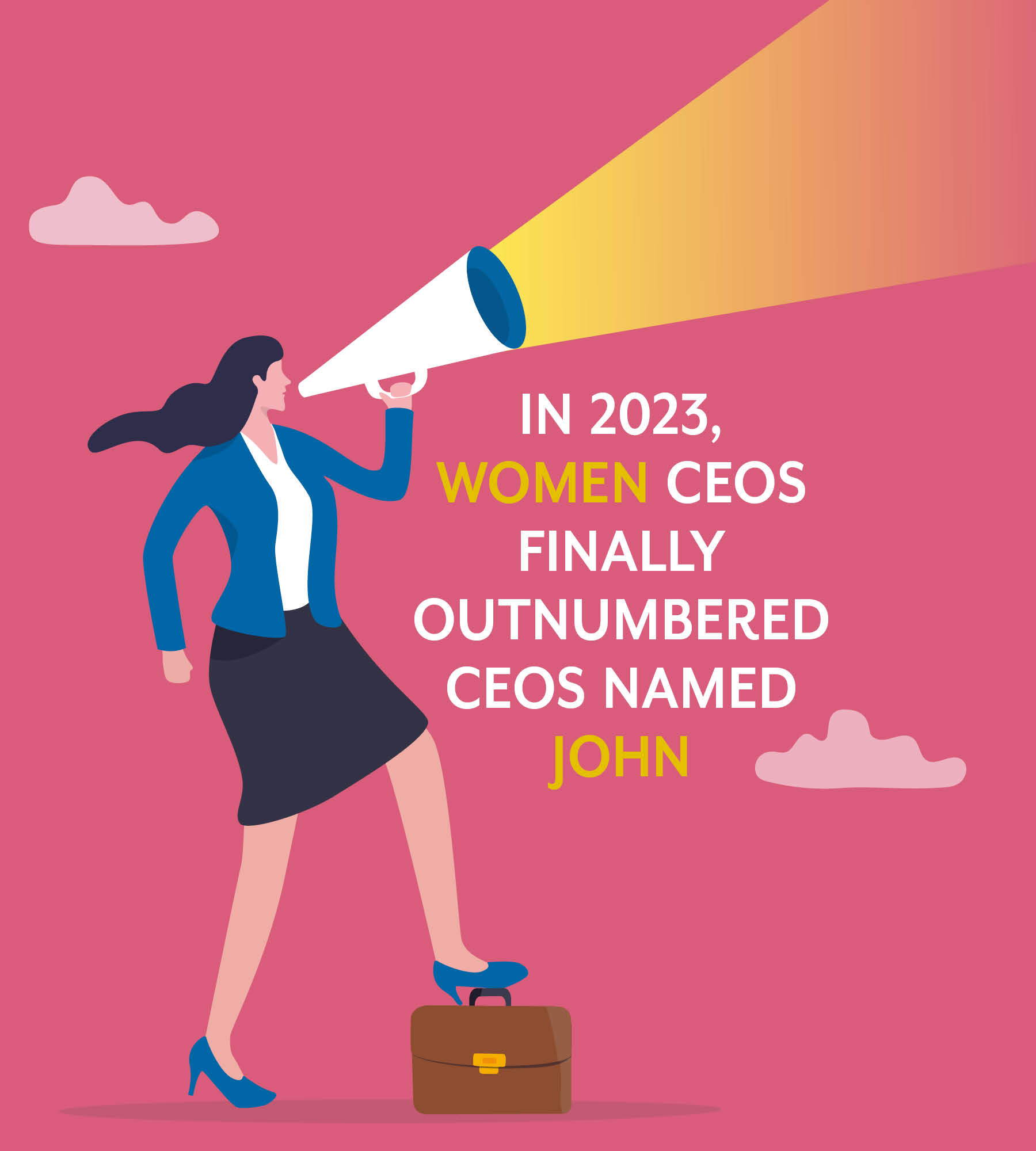Language
You can read the magazine in one of the following languages
The year 2023 was a great year for women’s empowerment. For the first time in history, a solo female won the Nobel Memorial Prize in Economic Sciences, we saw blockbuster successes like Taylor Swift’s Eras Tour and the movie Barbie, and with 10 new female CEOs joining companies in the S&P 500 index, women are now finally outnumbering CEOs with the first name ‘John’.
However, neither Barbie lead actress Margot Robbie nor director Greta Gerwig were nominated for an Oscar, while Ryan Gosling (Ken) was. Something similar is happening in the business world. Female representation at the top of companies is still very low.
Only eight percent of CEO positions in the S&P 500 are held by women, and yet they represent more than 50 percent of the United States’ population. In contrast, men named John represent only 3.27 percent of the United States’ population, and until recently, had greater representation than women among S&P 500 CEOs.

There is a long way to go. Daniela Brandazza, Senior Director and Analytical Manager at S&P Global Ratings and President of Women’s Initiative for Networking and Success at S&P Global, tells The CEO Magazine that we’re still far from gender equality at the CEO level in the more than 60 countries or geographies studied in their S&P Global report ‘Women CEOs: Leadership for a Diverse Future,’ but that we’re seeing improvement.
According to S&P Global’s research, health care, financial and industrial global sectors ranked highly with the largest shares of women CEOs. Lagging, however, were the utilities, energy and consumer staples sectors.
“Women CEOs remain unsurprisingly underrepresented, accounting for only 5.4 percent of all CEOs globally. Norway has the highest percentage, with 13.4 percent,” she says.
Countries with a higher proportion of women in executive positions also tend to have a more balanced labor force participation between men and women. “The gender gap in the labor force explains about 13 percent of the cross-country variation in the CEO gender gap,” Brandazza says.

1. Norway
2. Singapore
3. Thailand
4. Sweden
5. Taiwan
6. Hong Kong
7. France
8. China
9. Ireland
10. Philippines
11. Poland
12. Belgium
13. Finland
14. United Kingdom
15. Australia
1.Brazil
2. Japan
3. Mexico
4. Saudi Arabia
5. Russia
6. India
7. Netherlands
8. Israel
9. Turkey
10. Bermuda
11. Spain
12. Chile
13. Canada
14. Italy
15. Austria
Brandazza believes that policymaking could play a role in closing the gap, reminding us that countries with better access to child care are more likely to attract and retain a higher share of women in the workforce.
“Only then can larger numbers of women start a career, climb the ladder and one day, perhaps, become CEO,” she says.
According to their research, of the 15 most gender-equal jurisdictions, 10 increased their share of women CEOs in the past two years, while six of the 15 least gender-equal jurisdictions, experienced declines (Mexico, Italy, Israel, Malaysia, the Netherlands and Bermuda).
It is easier to find a female CEO in the Philippines than in Japan.
During the first months of the COVID-19 pandemic, the global press hailed the performance of women leaders in New Zealand, South Korea and Germany.
The press stories suggested that women in power seemed to be more responsible, caring and prudent, while men were more willing to improvise, minimize the perils and make risky decisions.
In the context of the healthcare crisis, Brandazza’s team analyzed transcripts of earnings calls from the leaders of 5,801 companies in the S&P Global BMI index from January 1, 2020 through to March 31, 2022.
“Our latest data indicate that the type of positive communication style favored often by women CEOs seems more aligned with the concept of authentic leadership that draws from and mirrors the diversity of society. A different leadership style than one practiced by their male counterparts,” she says.
It is clear that women lead differently, but why should men who dominate the leadership landscape want to adopt a more empathetic and positive communication style? What incentives exist to change the status quo, other than voluntary corporate policies that promote diversity, equity and inclusion?
According to Brandazza’s statements in the S&P Global report, the answer lies in the future of employment.
“A new generation is joining the labor market, bringing with them different ideas about the meaning of work. These ideas tend to include more flexible conditions, a quest for personal growth, the yearning for a greater purpose and, of course, a strong sense of justice,” she said.
“This includes companies being accountable not only to their shareholders but also to the communities they serve and society at large.
“The COVID-19 pandemic accelerated this yearning for new ways of working, as employees from previous generations were suddenly introduced to the benefits and challenges of a much more flexible and dynamic labor paradigm.”
Brandazza believes that this qualitative demand from the labor force, combined with the already pressing shortage of skilled people in many nations could be the not-so-subtle nudge that companies are needing to recognize, nurture and promote a new kind of leadership.
“One that is more diverse, empathetic and inclusive, in order to attract, retain, develop and inspire the talent that is critical to success,” she said.

Meanwhile, Maria Ariza, CEO of the Bolsa Institucional de Valores (BIVA) in Mexico, and one of a handful of women in the world to oversee a stock exchange, highlights achievements so far.
“I believe that progress has been made so that women have greater access to opportunities and greater participation in decision-making spaces. Obviously we still have a long way to go, but we have already achieved a change of paradigm and raised the awareness of the business and investment sectors,” she says.
Ariza, who is one of the top CEOs in one of the countries with the lowest participation of women in leadership positions according to S&P Global BMI index, believes that in order to gain more seats at the table, women must continue to show determination and commitment.
“It is not only about closing the gap in terms of economic remuneration, it is also important to seek recognition and equity in career opportunities. Gender equality is not only a moral imperative, but also a driver of economic and financial success for companies and countries in general,” she shares.
According to Ariza, it’s about teaming up and including men in women’s forums, not excluding them, as “men play a key role in equity changes.”
Gosling’s response to Robbie and Gerwig’s omission from the 96th Academy Awards nominations is the perfect example of this approach. “There is no Ken without Barbie, and there is no Barbie movie without Greta Gerwig and Margot Robbie, the two people most responsible for this history-making, globally celebrated film,” the actor said in a statement following the nominations announcement.
“No recognition would be possible for anyone on the film without their talent, grit and genius. To say that I’m disappointed that they are not nominated in their respective categories would be an understatement … Their work should be recognized along with the other very deserving nominees.”
